Life Cycle Assessment Applied to End-of-Life Scenarios of Sargassum spp. for Application in Civil Construction
Abstract
1. Introduction
2. Materials and Methods
2.1. Scope Definition
- (a)
- Natural decomposition on the beach (current reference scenario);
- (b)
- Landfill disposal;
- (c)
- Drying and grinding for use as fibers or particles;
- (d)
- Generation of energy and fly ash from burning biomass.
2.1.1. Life Cycle Inventory (LCI) Modeling Structure
Sargassum Decomposition Emissions Inventory
Sargassum Burning Emissions Inventory for Power Generation
- ωT: Thermal NO formation rate per time (mol/cm3.s)
- Teq: Temperature (K)
- [O2]: Oxygen concentration in mol/cm3
- [N2]: Nitrogen concentration in mol/cm3
2.1.2. Life Cycle Impact Assessment (LCIA) and Interpretation
2.1.3. Method Limitations, Assumptions, and Impacts
3. Results and Discussion
3.1. End-of-Life Scenario I: Decomposition of Sargassum Algae on the Beach
3.2. End-of-Life Scenario II: Decomposition of Sargassum Algae in Landfill
3.3. End-of-Life Scenario III: Processing Sargassum Algae for Use as Fibers or Particles
3.4. End-of-Life Scenario IV: Biomass Burning for Power/Fly Ash Generation
3.5. Comparison among Scenarios
3.6. Comparative Analysis of Environmental Impact Potentials of Particle Production from Biomass of Sargassum Algae and Sugarcane
3.7. Comparative Analysis of Environmental Impact Potentials among Sargassum Fly Ash, Sugarcane Bagasse Fly Ash, and Limestone
4. Conclusions
Supplementary Materials
Author Contributions
Funding
Data Availability Statement
Acknowledgments
Conflicts of Interest
References
- Pörtner, H.-O.; Roberts, D.C.; Tignor, M.; Poloczanska, E.S.; Mintenbeck, K.; Alegría, A.; Craig, M.; Langsdorf, S.; Löschke, S.; Möller, V.; et al. Contribution of Working Group II to the Sixth Assessment Report of the Intergovernmental Panel on Climate Change. In Climate Change 2022: Impacts, Adaptation, and Vulnerability; IPCC: Geneva, Switzerland, 2022; ISBN 9789291691586. [Google Scholar]
- Haines, A.; Kovats, R.S.; Campbell-Lendrum, D.; Corvalan, C. Climate Change and Human Health: Impacts, Vulnerability and Public Health. Public Health 2006, 120, 585–596. [Google Scholar] [CrossRef]
- Patz, J.A.; Frumkin, H.; Holloway, T.; Vimont, D.J.; Haines, A. Climate Change. JAMA 2014, 312, 1565. [Google Scholar] [CrossRef] [PubMed]
- Trainer, V.L.; Moore, S.K.; Hallegraeff, G.; Kudela, R.M.; Clement, A.; Mardones, J.I.; Cochlan, W.P. Pelagic Harmful Algal Blooms and Climate Change: Lessons from Nature’s Experiments with Extremes. Harmful Algae 2020, 91, 101591. [Google Scholar] [CrossRef] [PubMed]
- Arabadzhyan, A.; Figini, P.; García, C.; González, M.M.; Lam-González, Y.E.; León, C.J. Climate Change, Coastal Tourism, and Impact Chains—A Literature Review. Curr. Issues Tour. 2021, 24, 2233–2268. [Google Scholar] [CrossRef]
- Resiere, D.; Mehdaoui, H.; Névière, R.; Mégarbane, B. Sargassum Invasion in the Caribbean: The Role of Medical and Scientific Cooperation. Rev. Panam. Salud Pública 2019, 43, 1. [Google Scholar] [CrossRef]
- Sissini, M.N.; de Barros Barreto, M.B.B.; Széchy, M.T.M.; de Lucena, M.B.; Oliveira, M.C.; Gower, J.; Liu, G.; de Oliveira Bastos, E.; Milstein, D.; Gusmão, F.; et al. The Floating Sargassum (Phaeophyceae) of the South Atlantic Ocean—Likely Scenarios. Phycologia 2017, 56, 321–328. [Google Scholar] [CrossRef]
- Rossignolo, J.A.; Felicio Peres Duran, A.J.; Bueno, C.; Martinelli Filho, J.E.; Savastano Junior, H.; Tonin, F.G. Algae Application in Civil Construction: A Review with Focus on the Potential Uses of the Pelagic Sargassum spp. Biomass. J. Environ. Manag. 2022, 303, 114258. [Google Scholar] [CrossRef]
- Oviatt, C.A.; Huizenga, K.; Rogers, C.S.; Miller, W.J. What Nutrient Sources Support Anomalous Growth and the Recent Sargassum Mass Stranding on Caribbean Beaches? A Review. Mar. Pollut. Bull. 2019, 145, 517–525. [Google Scholar] [CrossRef]
- Resiere, D.; Mehdaoui, H.; Florentin, J.; Gueye, P.; Lebrun, T.; Blateau, A.; Viguier, J.; Valentino, R.; Brouste, Y.; Kallel, H.; et al. Sargassum Seaweed Health Menace in the Caribbean: Clinical Characteristics of a Population Exposed to Hydrogen Sulfide during the 2018 Massive Stranding. Clin. Toxicol. 2021, 59, 215–223. [Google Scholar] [CrossRef]
- Milledge, J.; Harvey, P. Golden Tides: Problem or Golden Opportunity? The Valorisation of Sargassum from Beach Inundations. J. Mar. Sci. Eng. 2016, 4, 60. [Google Scholar] [CrossRef]
- Thompson, T.M.; Young, B.R.; Baroutian, S. Efficiency of Hydrothermal Pretreatment on the Anaerobic Digestion of Pelagic Sargassum for Biogas and Fertiliser Recovery. Fuel 2020, 279, 118527. [Google Scholar] [CrossRef]
- de Souza Coracao, A.C.; Dos Santos, F.S.; Duarte, J.A.D.; Lopes-Filho, E.A.P.; De-Paula, J.C.; Rocha, L.M.; Krepsky, N.; Fiaux, S.B.; Teixeira, V.L. What Do We Know about the Utilization of the Sargassum Species as Biosorbents of Trace Metals in Brazil? J. Environ. Chem. Eng. 2020, 8, 103941. [Google Scholar] [CrossRef]
- Abdullah, M.A.; Ahmad, A.; Shah, S.M.U.; Shanab, S.M.M.; Ali, H.E.A.; Abo-State, M.A.M.; Othman, M.F. Integrated Algal Engineering for Bioenergy Generation, Effluent Remediation, and Production of High-Value Bioactive Compounds. Biotechnol. Bioprocess Eng. 2016, 21, 236–249. [Google Scholar] [CrossRef]
- Kalia, V.C.; Prakash, J.; Koul, S. Biorefinery for Glycerol Rich Biodiesel Industry Waste. Indian J. Microbiol. 2016, 56, 113–125. [Google Scholar] [CrossRef]
- Puspita, M.; Setyawidati, N.A.R.; Stiger-Pouvreau, V.; Vandanjon, L.; Widowati, I.; Radjasa, O.K.; Bedoux, G.; Bourgougnon, N. Indonesian Sargassum Species Bioprospecting: Potential Applications of Bioactive Compounds and Challenge for Sustainable Development. In Advances in Botanical Research; Academic Press: Cambridge, MA, USA, 2020; pp. 113–161. [Google Scholar]
- López-Sosa, L.B.; Alvarado-Flores, J.J.; Corral-Huacuz, J.C.; Aguilera-Mandujano, A.; Rodríguez-Martínez, R.E.; Guevara-Martínez, S.J.; Alcaraz-Vera, J.V.; Rutiaga-Quiñones, J.G.; Zárate-Medina, J.; Ávalos-Rodríguez, M.L.; et al. A Prospective Study of the Exploitation of Pelagic Sargassum spp. as a Solid Biofuel Energy Source. Appl. Sci. 2020, 10, 8706. [Google Scholar] [CrossRef]
- Desrochers, A.; Cox, S.; Oxenford, H.; Van Tussenbroek, B. Sargassum Uses Guide: A Resource for Caribbean Researchers, Entrepreneurs and Policy Makers Lead; Food and Agriculture Organization: Rome, Italy, 2020. [Google Scholar]
- Amador-Castro, F.; García-Cayuela, T.; Alper, H.S.; Rodriguez-Martinez, V.; Carrillo-Nieves, D. Valorization of Pelagic Sargassum Biomass into Sustainable Applications: Current Trends and Challenges. J. Environ. Manag. 2021, 283, 112013. [Google Scholar] [CrossRef]
- EPE (Empresa de Pesquisa Energética). Brazilian Energy Balance 2021 Year 2020/Empresa de Pesquisa Energética; EPE: Rio de Janeiro, Brazil, 2021. [Google Scholar]
- Martinelli Filho, J.E.; Morais, L.M.S.; Aviz, D. Can the Invertebrate Fauna Associated to Pelagic Sargassum Landings in the Brazilian Amazon Coast Aid Us to Understand Its Origin and Dispersion? In Proceedings of the Sixty Eighth Annual Gulf and Caribbean Fisheries Institute, Panama, Central America, 9–15 November 2016; pp. 14–17. [Google Scholar]
- Boyle, W.C. Energy Recovery from Sanitary Landfills—A Review. In Microbial Energy Conversion; Elsevier: Amsterdam, The Netherlands, 1977; pp. 119–138. [Google Scholar]
- Symons, G.E.; Buswell, A.M. The Methane Fermentation of Carbohydrates 1,2. J. Am. Chem. Soc. 1933, 55, 2028–2036. [Google Scholar] [CrossRef]
- Channiwala, S.A.; Parikh, P.P. A Unified Correlation for Estimating HHV of Solid, Liquid and Gaseous Fuels. Fuel 2002, 81, 1051–1063. [Google Scholar] [CrossRef]
- Wang, S.; Cao, B.; Abomohra, A.E.-F.; Hu, Y.; Wang, Q.; He, Z.; Xu, S.; Feng, Y.; Bernard, U.B.; Jiang, X. Comparative Study of Combustion Properties of Two Seaweeds in a Batch Fluidized Bed. Combust. Sci. Technol. 2018, 190, 755–769. [Google Scholar] [CrossRef]
- Achinas, S.; Euverink, G.J.W. Theoretical Analysis of Biogas Potential Prediction from Agricultural Waste. Resour. Technol. 2016, 2, 143–147. [Google Scholar] [CrossRef]
- Allen, E.; Wall, D.M.; Herrmann, C.; Xia, A.; Murphy, J.D. What Is the Gross Energy Yield of Third Generation Gaseous Biofuel Sourced from Seaweed? Energy 2015, 81, 352–360. [Google Scholar] [CrossRef]
- Bird, K.T.; Chynoweth, D.P.; Jerger, D.E. Effects of Marine Algal Proximate Composition on Methane Yields. J. Appl. Phycol. 1990, 2, 207–213. [Google Scholar] [CrossRef]
- Milledge, J.J.; Maneein, S.; Arribas López, E.; Bartlett, D. Sargassum Inundations in Turks and Caicos: Methane Potential and Proximate, Ultimate, Lipid, Amino Acid, Metal and Metalloid Analyses. Energies 2020, 13, 1523. [Google Scholar] [CrossRef]
- Mousavi, S.M.; Fatehi, H.; Bai, X.-S. Numerical Study of the Combustion and Application of SNCR for NO Reduction in a Lab-Scale Biomass Boiler. Fuel 2021, 293, 120154. [Google Scholar] [CrossRef]
- Horvat, I.; Dović, D.; Filipović, P. Numerical and Experimental Methods in Development of the Novel Biomass Combustion System Concept for Wood and Agro Pellets. Energy 2021, 231, 120929. [Google Scholar] [CrossRef]
- Medina, P.; Núñez, J.; Ruiz-García, V.M.; Beltrán, A. Experimental and Numerical Comparison of CO2 Mass Flow Rate Emissions, Combustion and Thermal Performance for a Biomass Plancha-Type Cookstove. Energy Sustain. Dev. 2021, 63, 153–159. [Google Scholar] [CrossRef]
- Backa, A.; Nosek, R.; Čaja, A. The Analytical Model of Biomass Combustion. MATEC Web Conf. 2020, 328, 04003. [Google Scholar] [CrossRef]
- Martins, C.A.; Ferreira, M.A. Considerações Sobre a Formação de NOx Na Combustão. In Proceedings of the VI National Congress of Mechanical Engineering, Campina Grande, Brazil, 18–21 August 2010; pp. 18–21. [Google Scholar]
- Hayhurst, A.N.; Vince, I.M. Nitric Oxide Formation from N2 in Flames: The Importance of “Prompt” NO. Prog. Energy Combust. Sci. 1980, 6, 35–51. [Google Scholar] [CrossRef]
- Bowman, C.T. Control of Combustion-Generated Nitrogen Oxide Emissions: Technology Driven by Regulation. Symp. Combust. 1992, 24, 859–878. [Google Scholar] [CrossRef]
- Kravetz, C. Estudo do Desempenho Energético das Caldeiras da Indústria de Polpa Celulósica Kraft; Universidade de São Paulo: São Paulo, Brazil, 2018. [Google Scholar]
- La Picirelli de Souza, L.; Rajabi Hamedani, S.; Silva Lora, E.E.; Escobar Palacio, J.C.; Comodi, G.; Villarini, M.; Colantoni, A. Theoretical and Technical Assessment of Agroforestry Residue Potential for Electricity Generation in Brazil towards 2050. Energy Rep. 2021, 7, 2574–2587. [Google Scholar] [CrossRef]
- Driemeier, C.E.; Ling, L.Y.; Yancy-Caballero, D.; Mantelatto, P.E.; Dias, C.S.B.; Archilha, N.L. Location of Water in Fresh Sugarcane Bagasse Observed by Synchrotron X-ray Microtomography. PLoS ONE 2018, 13, e0208219. [Google Scholar] [CrossRef]
- Mendes, R.F.; Mendes, L.M.; Oliveira, S.L.; Freire, T.P. Use of Sugarcane Bagasse for Particleboard Production. Key Eng. Mater. 2014, 634, 163–171. [Google Scholar] [CrossRef]
- Silva, D.A.L.; Lahr, F.A.R.; Pavan, A.L.R.; Saavedra, Y.M.B.; Mendes, N.C.; Sousa, S.R.; Sanches, R.; Ometto, A.R. Do Wood-Based Panels Made with Agro-Industrial Residues Provide Environmentally Benign Alternatives? An LCA Case Study of Sugarcane Bagasse Addition to Particle Board Manufacturing. Int. J. Life Cycle Assess. 2014, 19, 1767–1778. [Google Scholar] [CrossRef]
- Silva, M.R.; Pinheiro, R.V.; Christoforo, A.L.; Panzera, T.H.; Lahr, F.A.R. Hybrid Sandwich Particleboard Made with Sugarcane, Pínus Taeda Thermally Treated and Malva Fibre from Amazon. Mater. Res. 2017, 21. [Google Scholar] [CrossRef]
- Khawaja, S.A.; Javed, U.; Zafar, T.; Riaz, M.; Zafar, M.S.; Khan, M.K. Eco-Friendly Incorporation of Sugarcane Bagasse Ash as Partial Replacement of Sand in Foam Concrete. Clean. Eng. Technol. 2021, 4, 100164. [Google Scholar] [CrossRef]
- de Siqueira, A.A.; Cordeiro, G.C. Properties of Binary and Ternary Mixes of Cement, Sugarcane Bagasse Ash and Limestone. Constr. Build. Mater. 2022, 317, 126150. [Google Scholar] [CrossRef]
- Barbosa, L.D.S.N.S.; Hytönen, E.; Vainikka, P. Carbon Mass Balance in Sugarcane Biorefineries in Brazil for Evaluating Carbon Capture and Utilization Opportunities. Biomass Bioenergy 2017, 105, 351–363. [Google Scholar] [CrossRef]
- Spósito, C.C.A.; Fazzan, J.V.; Rossignolo, J.A.; Bueno, C.; Spósito, F.A.; Akasaki, J.L.; Tashima, M.M. Ecodesign: Approaches for Sugarcane Bagasse Ash Mortars a Brazilian Context. J. Clean. Prod. 2023, 385, 135667. [Google Scholar] [CrossRef]
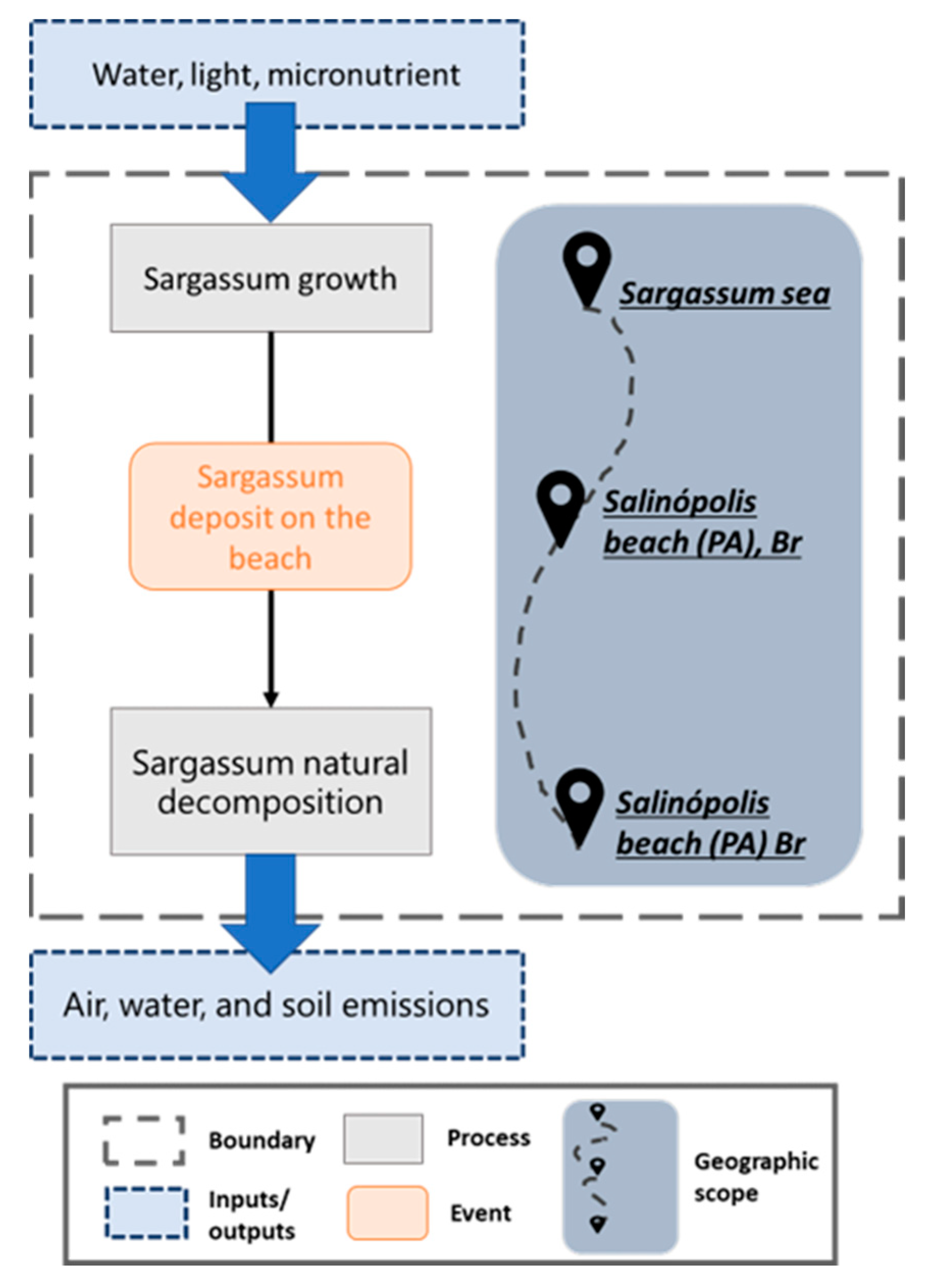
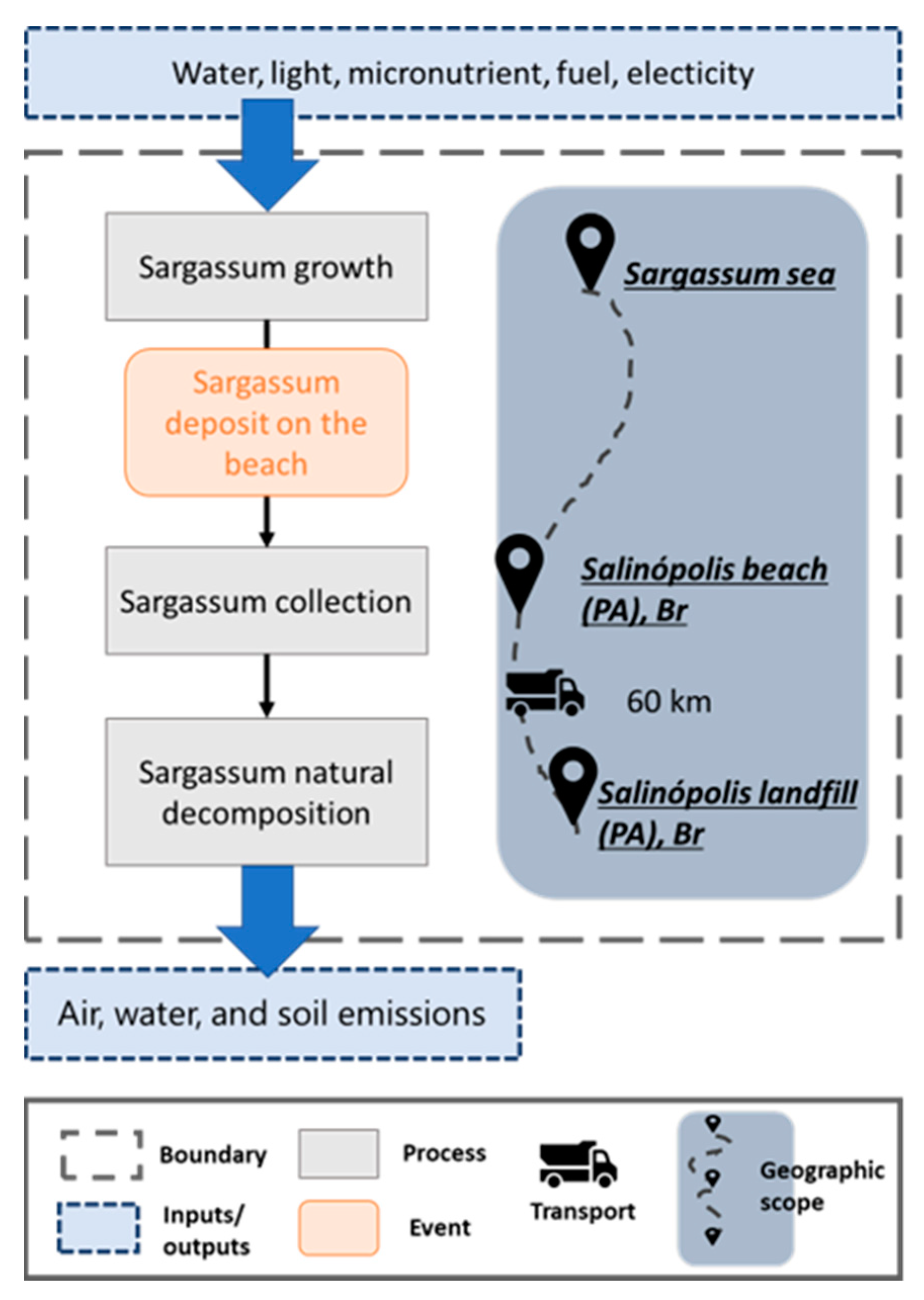
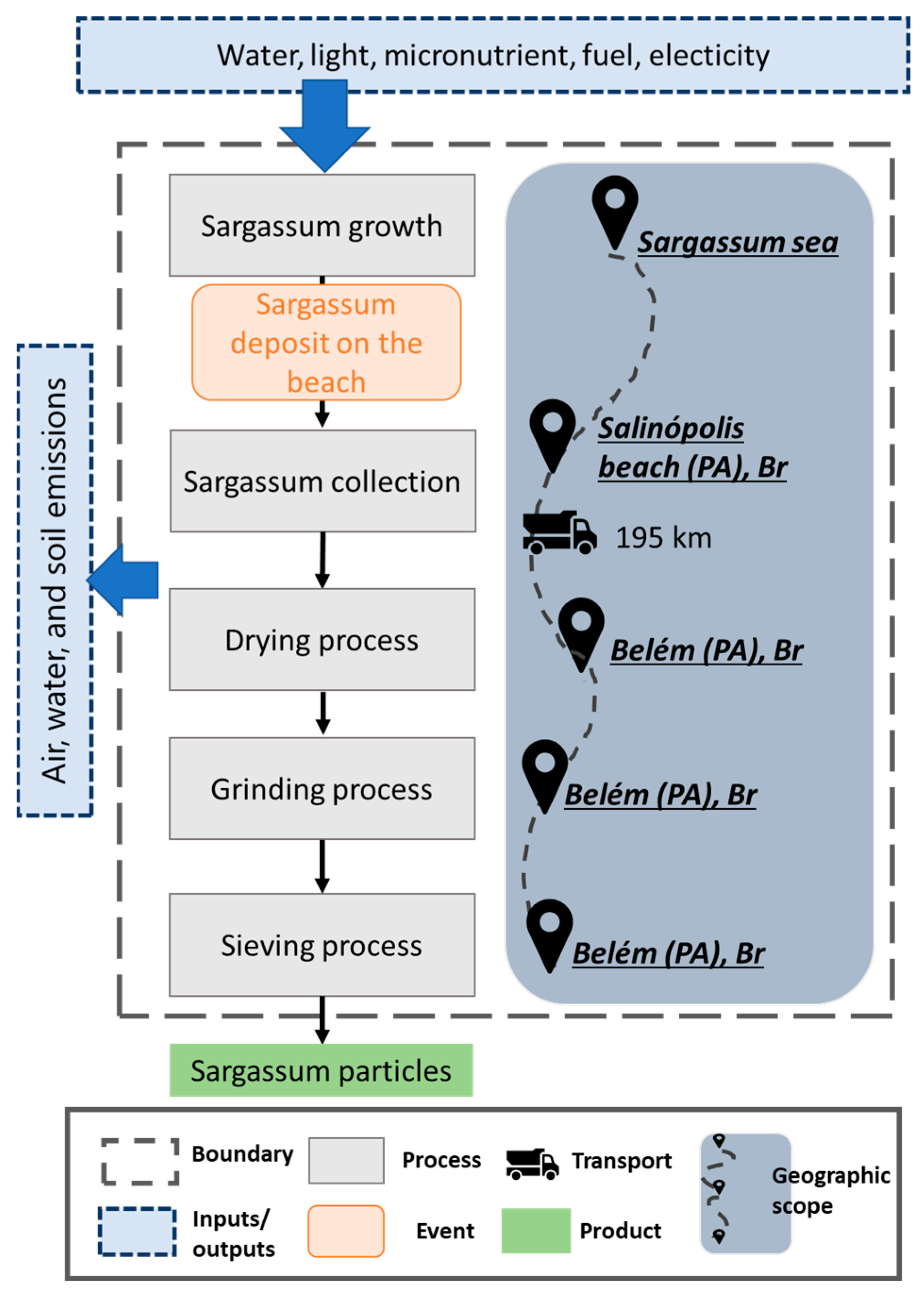

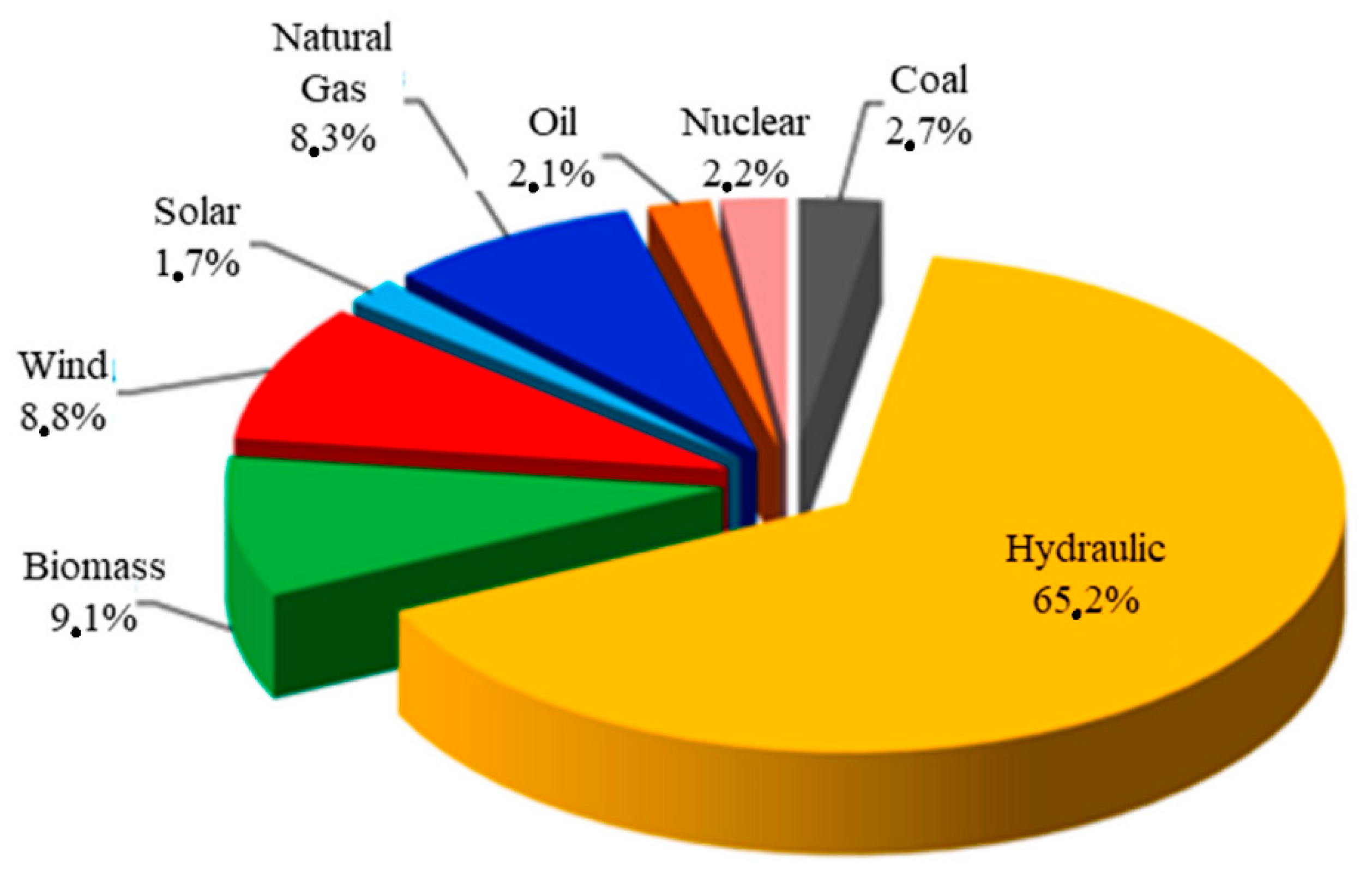
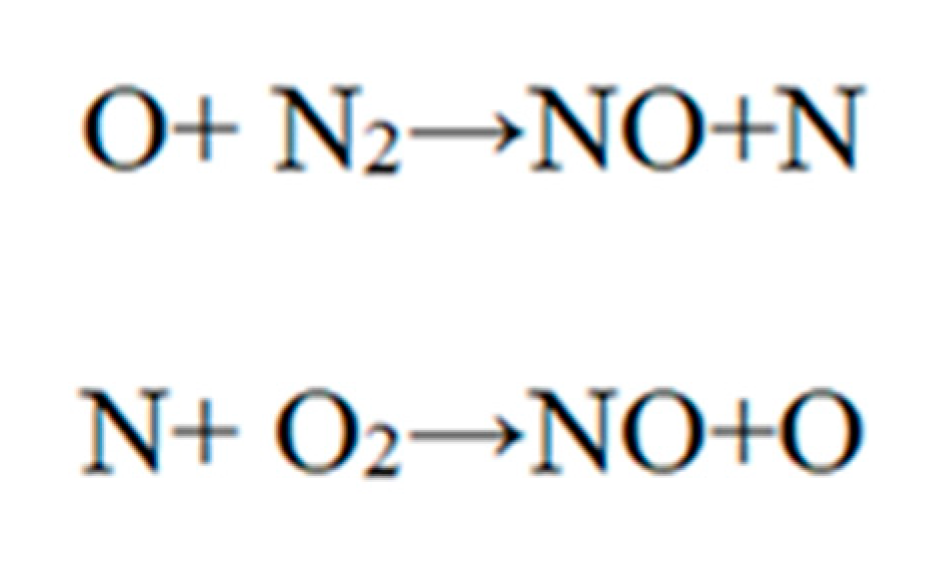


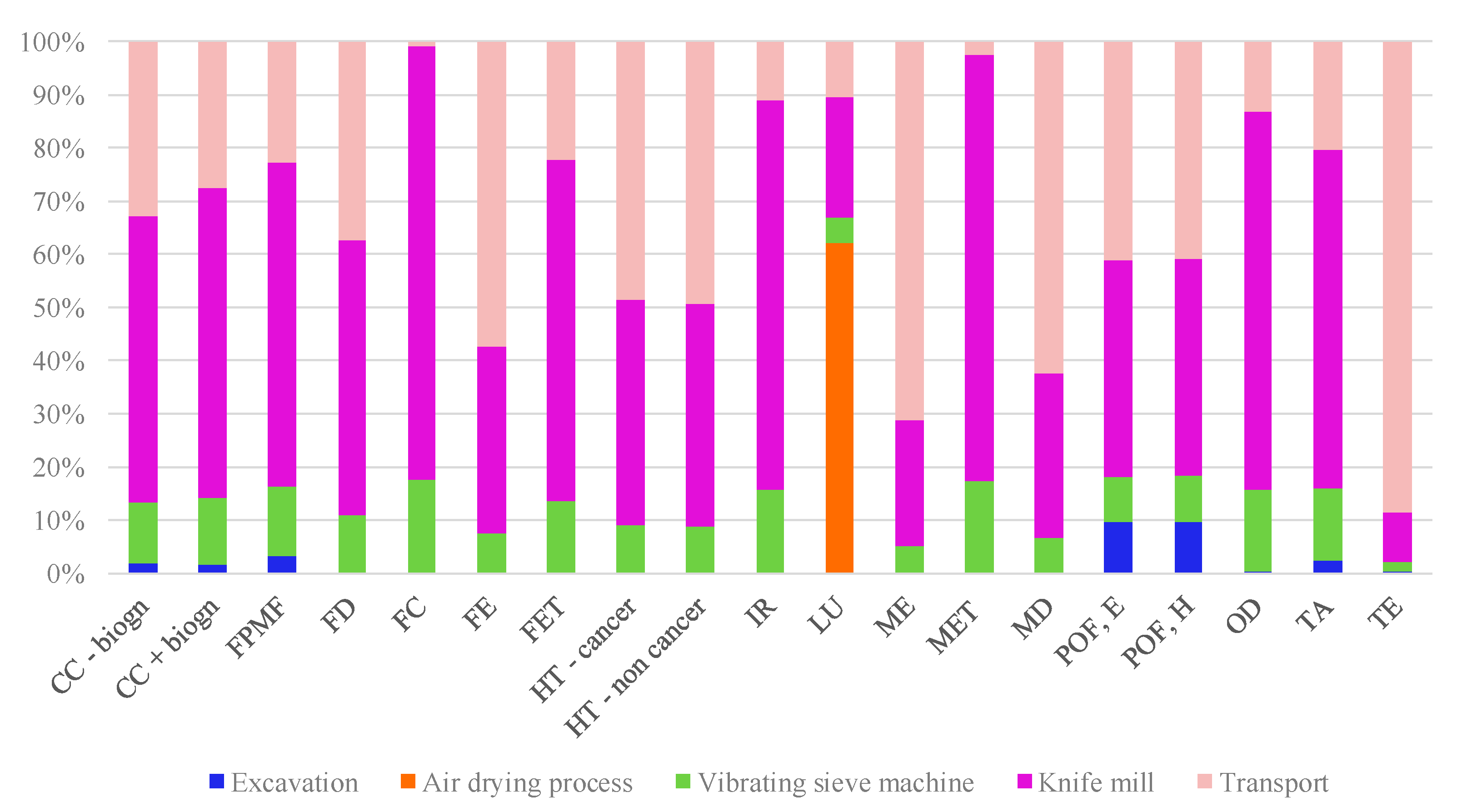
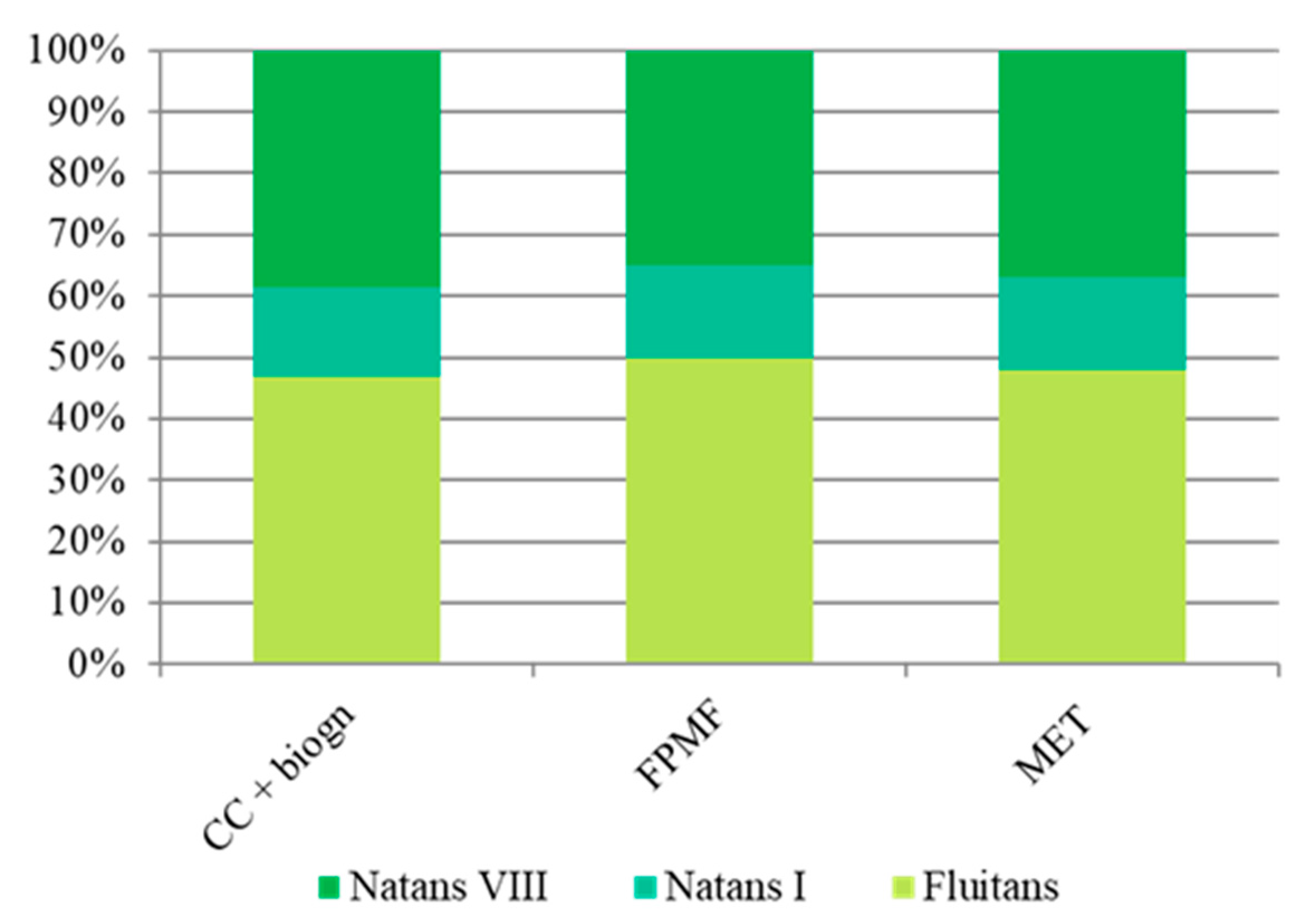







| Categories of Impact | Acronym |
|---|---|
| Climate change, default, excl biogenic carbon [kg CO2 eq.] | CC—biogen |
| Climate change, incl biogenic carbon [kg CO2 eq.] | CC + biogen |
| Fine particulate matter formation [kg PM2.5 eq.] | FPMF |
| Fossil depletion [kg oil eq.] | FD |
| Freshwater consumption [m3] | FC |
| Freshwater ecotoxicity [kg 1,4 DB eq.] | FE |
| Freshwater eutrophication [kg P eq.] | FET |
| Human toxicity, cancer [kg 1,4-DB eq.] | HT cancer |
| Human toxicity, non-cancer [kg 1,4-DB eq.] | HT non cancer |
| Ionizing radiation [kBq Co-60 eq. to air] | IR |
| Land use [Annual crop eq.·y] | LU |
| Marine ecotoxicity [kg 1,4-DB eq.] | ME |
| Marine eutrophication [kg N eq.] | MET |
| Metal depletion [kg Cu eq.] | MD |
| Photochemical ozone formation, ecosystems [kg NOx eq.] | POF, E |
| Photochemical ozone formation, human health [kg NOx eq.] | POF, H |
| Stratospheric ozone depletion [kg CFC-11 eq.] | OD |
| Terrestrial acidification [kg SO2 eq.] | TA |
| Terrestrial ecotoxicity [kg 1,4-DB eq.] | TE |
| Parameter | S. fluitans | S. natans I | S. natans VIII |
|---|---|---|---|
| Carbon (% TS) | 29.91 | 31.03 | 35.12 |
| Hydrogen (% TS) | 4.17 | 4.13 | 4.53 |
| Nitrogen (% TS) | 1.59 | 1.29 | 1.24 |
| Oxygen (% TS) | 32.53 | 31.09 | 39.96 |
| Sulfur (% TS) | 0.46 | 0.13 | 0.14 |
| Moisture (%) | 87.5 | 87.5 | 87.5 |
| Empirical formula | C2.49H4.14O2.03N0.114S0.014 | C2.58H4.10O1.94N0.092S0.004 | C2.92H4.50O2.50N0.088S0.004 |
| S. fluitans | S. natans I | S. natans VIII | |||||||
|---|---|---|---|---|---|---|---|---|---|
| GHG | TEB g/kg TS | CTEB * g/kg TS | CTEB ** g/kg (unprocessed) | TEB g/kg TS | CTEB * g/kg TS | CTEB ** g/kg (unprocessed) | TEB g/kg TS | CTEB * g/kg TS | CTEB ** g/kg (unprocessed) |
| CH4 | 194 | 56.2 | 7.02 | 206 | 35.0 | 4.37 | 219 | 81.1 | 10.1 |
| CO2 | 564 | 164 | 20.4 | 572 | 97.3 | 12.2 | 686 | 254 | 31.7 |
| NH3 | 19 | 5.6 | 0.70 | 16 | 2.7 | 0.33 | 15 | 5.6 | 0.70 |
| H2S | 4.9 | 1.4 | 0.18 | 1.4 | 0.23 | 0.029 | 1.5 | 0.57 | 0.071 |
| S. natans I | |||||
|---|---|---|---|---|---|
| CO2 | CO | SO2 | N2 | O2 | NO |
| 2.91 × 10−01 | 1.20 × 10−02 | 6.43 × 10−04 | 7.48 × 10−01 | 2.29 × 10−01 | 2.46 × 10−12 |
| Energy produced by boilers (MJ/Kg of algae) | |||||
| 5.51 × 10−01 | |||||
| S. fluitans | |||||
| CO2 | CO | SO2 | N2 | O2 | NO |
| 2.81 × 10−01 | 1.16 × 10−02 | 2.46 × 10−03 | 7.20 × 10−01 | 2.20 × 10−01 | 2.37 × 10−12 |
| Energy produced by boilers (MJ/Kg of algae) | |||||
| 5.26 × 10−01 | |||||
| S. natans VIII | |||||
| CO2 | CO | SO2 | N2 | O2 | NO |
| 3.30 × 10−01 | 1.36 × 10−02 | 7.72 × 10−04 | 7.94 × 10−01 | 2.43 × 10−01 | 2.61 × 10−12 |
| Energy produced by boilers (MJ/Kg of algae) | |||||
| 5.80 × 10−01 | |||||
Disclaimer/Publisher’s Note: The statements, opinions and data contained in all publications are solely those of the individual author(s) and contributor(s) and not of MDPI and/or the editor(s). MDPI and/or the editor(s) disclaim responsibility for any injury to people or property resulting from any ideas, methods, instructions or products referred to in the content. |
© 2023 by the authors. Licensee MDPI, Basel, Switzerland. This article is an open access article distributed under the terms and conditions of the Creative Commons Attribution (CC BY) license (https://creativecommons.org/licenses/by/4.0/).
Share and Cite
Bueno, C.; Rossignolo, J.A.; Gavioli, L.M.; Sposito, C.C.A.; Tonin, F.G.; Veras, M.M.; Moraes, M.J.B.d.; Lyra, G.P. Life Cycle Assessment Applied to End-of-Life Scenarios of Sargassum spp. for Application in Civil Construction. Sustainability 2023, 15, 6254. https://doi.org/10.3390/su15076254
Bueno C, Rossignolo JA, Gavioli LM, Sposito CCA, Tonin FG, Veras MM, Moraes MJBd, Lyra GP. Life Cycle Assessment Applied to End-of-Life Scenarios of Sargassum spp. for Application in Civil Construction. Sustainability. 2023; 15(7):6254. https://doi.org/10.3390/su15076254
Chicago/Turabian StyleBueno, Cristiane, João Adriano Rossignolo, Letícia Missiatto Gavioli, Camila Cassola Assunção Sposito, Fernando Gustavo Tonin, Mariana Matera Veras, Maria Júlia Bassan de Moraes, and Gabriela Pitolli Lyra. 2023. "Life Cycle Assessment Applied to End-of-Life Scenarios of Sargassum spp. for Application in Civil Construction" Sustainability 15, no. 7: 6254. https://doi.org/10.3390/su15076254
APA StyleBueno, C., Rossignolo, J. A., Gavioli, L. M., Sposito, C. C. A., Tonin, F. G., Veras, M. M., Moraes, M. J. B. d., & Lyra, G. P. (2023). Life Cycle Assessment Applied to End-of-Life Scenarios of Sargassum spp. for Application in Civil Construction. Sustainability, 15(7), 6254. https://doi.org/10.3390/su15076254









